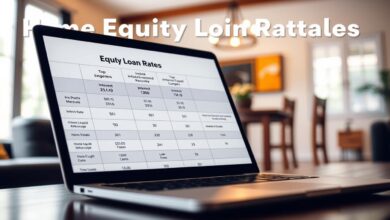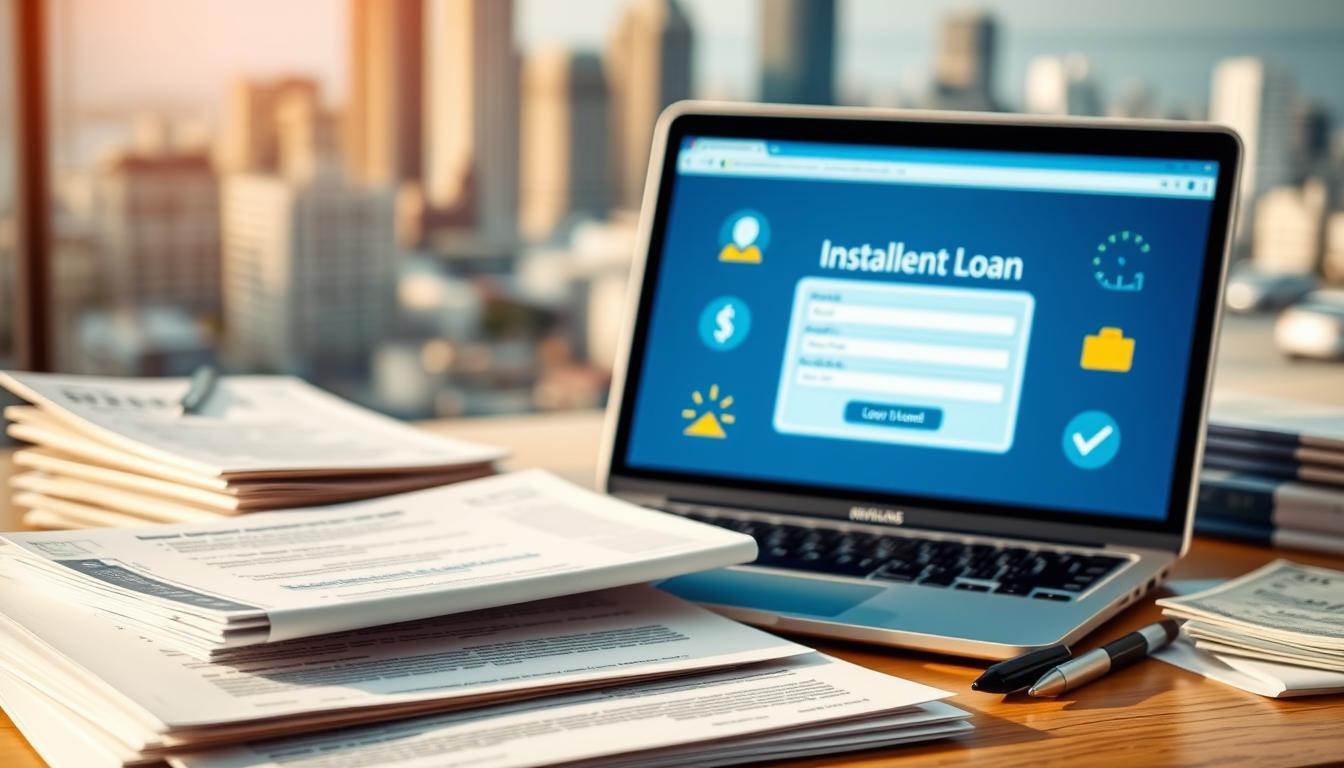Unlock Cash with an Equity Loan: Expert Guidance
Your property’s value isn’t just a number on paper—it’s a powerful financial tool waiting to be tapped. If you’ve built up substantial ownership in your house, you could access funds for major expenses like renovations, education, or debt consolidation. This guide will show you how to make smart decisions about leveraging this resource.
Many lenders offer competitive rates and terms for homeowners. For example, U.S. Bank provides fixed-rate solutions with no upfront fees and repayment timelines stretching up to three decades. The process is straightforward: check eligibility without affecting your credit score, and if approved, receive funds in as few as three business days after closing.
We’ll walk you through every step, from understanding basic requirements to advanced strategies. You’ll learn how to compare offers, avoid common pitfalls, and maximize the benefits of your property’s potential. Our friendly, jargon-free approach simplifies complex topics so you can move forward with confidence.
Key Takeaways
- Access large sums using your property’s built-up value as collateral
- Secure fixed rates and predictable payments over decades
- Explore options with no closing costs or credit score impact during prequalification
- Receive funds quickly—often within days of approval
- Discover smarter alternatives to high-interest credit cards or personal loans
Introduction: Unlocking the Power of Home Equity
Beyond shelter, your residence acts as a silent partner in wealth creation. Many homeowners don’t realize their living space holds financial potential that grows alongside property values and consistent mortgage payments.
Understanding Home Equity as an Asset
Your ownership stake in your property works like a savings account that builds automatically. Calculate it by subtracting your remaining mortgage balance from your home’s current market price. For instance, a $500,000 house with $275,000 owed leaves $225,000 available—a number that climbs as you pay down your loan or local real estate prices rise.
The Role of Home Equity in Financial Solutions
This built-up value becomes your golden ticket to better borrowing terms. Unlike credit cards or personal loans, lenders view this resource as low-risk collateral, often leading to lower interest rates. Families nationwide use these funds for kitchen remodels, college tuition, or combining high-interest debts into one manageable payment.
| Financial Resource | Growth Potential | Collateral Strength |
|---|---|---|
| Home Equity | Through payments + market gains | High (secured by property) |
| Savings Account | Fixed interest rates | None |
| Investment Portfolio | Market-dependent | Variable |
Smart homeowners treat their living spaces as evolving financial tools. Regular mortgage payments and strategic upgrades can accelerate your equity growth, turning four walls into a flexible resource for life’s surprises and opportunities.
What is an Equity Loan?
Imagine accessing cash without selling your house—this is the power of a home equity loan. These financial tools let you borrow against your property’s value while keeping ownership intact. Perfect for large expenses or consolidating high-interest debt, they offer stability when you need funds fast.
Defining the Equity Loan Option
A home equity installment loan, often called HELOAN, works like a traditional mortgage. You get one lump sum upfront, then repay it over 5–30 years with fixed monthly payments. Since your house secures the debt, lenders typically offer better rates than unsecured options like credit cards.
How does it differ from a line of credit? With HELOANs, you receive all the money immediately. No revolving balance—just predictable payments that simplify budgeting. “This structure helps families plan long-term expenses without payment surprises,” notes a recent banking report.
Your property acts as collateral, which means lower risk for lenders and better terms for you. Most institutions require at least 15–20% ownership stake in your home before approving these loans. Approval amounts depend on your credit score, income, and current market value.
Key features include:
- Fixed interest rates locked for the entire repayment period
- No restrictions on fund usage—renovate, travel, or pay medical bills
- Potential tax deductions when using money for home upgrades
How Home Equity Loans Work
Securing funds for major expenses becomes straightforward with predictable repayment structures. Let’s explore the mechanics that make this financial solution both reliable and adaptable to different budgets.
Fixed Interest Rates and Predictable Payments
Lenders lock your interest rate for the entire repayment period. This stability shields you from market changes—your monthly payment stays identical whether rates rise or fall. Consider a $50,000 amount borrowed at 7.65% over 10 years: you’d pay $597.43 every month like clockwork.
Fixed-rate plans transform uncertainty into clear math. “Borrowers appreciate knowing exactly when their last payment will occur,” states a U.S. Bank financial advisor. Unlike variable-rate options, you’ll never face surprise increases that strain your budget.
Choosing Your Repayment Timeline
Financial institutions offer flexible timelines to match various goals:
| Term Length | Monthly Payment | Total Interest |
|---|---|---|
| 5 years | $1,006 | $10,360 |
| 10 years | $597 | $21,692 |
| 20 years | $411 | $48,640 |
| 30 years | $347 | $74,920 |
Shorter terms (5-10 years) build ownership faster but require higher payments. Longer timelines (20-30 years) ease cash flow while costing more overall. Early payments primarily cover interest charges, gradually shifting to reduce principal as the schedule progresses.
Your choice depends on priorities—quick ownership or manageable monthly costs. Either way, fixed rates ensure your plan stays on track from first payment to final settlement.
Benefits of Using an Equity Loan for Home Improvements
Transforming your living space while boosting its market value is easier than you think. Smart financing options let you tackle major upgrades or streamline existing debts—all while keeping your budget intact.

Funding Renovation Projects and Upgrades
Major renovations become achievable with lump-sum financing. Popular projects like kitchen remodels or solar panel installations often pay off twice—enhancing daily comfort and increasing resale potential. A recent study shows bathroom upgrades alone can deliver a 60% return on investment when selling.
Energy-efficient improvements offer year-round benefits. Think new windows, insulation upgrades, or smart thermostats. These changes lower utility bills while making your house more attractive to eco-conscious buyers. Plus, interest payments for these projects might qualify for tax deductions—always consult a tax professional for details.
Opportunities for Debt Consolidation
High-interest debts from multiple sources can drain your budget. Combining them into one fixed-rate payment often cuts interest costs by half or more. For example, shifting $30,000 in credit card balances at 18% to a 7% rate saves $275 monthly—$3,300 annually.
This strategy simplifies money management. Instead of tracking five different due dates, you handle a single payment. “Consolidation gave us breathing room to save for emergencies,” shares a Colorado homeowner who reduced their monthly obligations by 40%.
| Financial Strategy | Average Savings | Long-Term Benefit |
|---|---|---|
| Home Upgrades | 5-15% value increase | Higher resale potential |
| Debt Consolidation | $200-$500/month | Faster debt elimination |
Qualifying for a Home Equity Loan
Meeting lender requirements opens doors to smarter financing choices. Lenders review three main factors: your financial track record, property value, and repayment capacity. Let’s break down what you’ll need to prepare.
Eligibility Criteria and Required Home Equity
Most institutions require at least 15-20% ownership in your property. This means if your house is worth $400,000, you’d need $60,000-$80,000 in built-up value. Some lenders like Bank of America let you borrow up to 85% of your home’s worth minus existing mortgage balances.
Your credit history plays a big role too. A FICO score of 660 is the baseline, but scores above 730 unlock better rates. “Borrowers with strong payment histories often qualify for premium terms,” notes a Chase Bank underwriter.
Credit Score and Debt-to-Income Considerations
Lenders calculate your debt-to-income ratio by comparing monthly obligations to earnings. Aim for a DTI below 43%—if you earn $6,000 monthly, keep debts under $2,580. Recent pay stubs and tax returns help prove stable income.
| Credit Tier | Score Range | Approval Odds |
|---|---|---|
| Excellent | 730+ | Highest rates/discounts |
| Good | 660-729 | Standard approval |
| Fair | 620-659 | Case-by-case review |
Boost your chances by paying down credit cards and fixing report errors. If denied, consider adding a co-borrower or exploring alternative financing. Remember—each prequalification check won’t hurt your credit score, so shop around confidently.
Application Process and Fast Approval
Getting started with your financial plan is simpler than you might expect. Modern lenders have streamlined their systems to make borrowing straightforward and stress-free. You’ll find multiple ways to begin—all designed to fit busy schedules.
Online Prequalification and Easy Application
Begin with a 15-minute digital form that asks basic questions about your property and income. This soft-check process won’t affect your credit score. “Over 80% of applicants receive preliminary approval within minutes,” reports a U.S. Bank representative.
You’ll need:
- Current mortgage balance
- Recent earnings statements
- Desired funding amount
Required Documentation and Timelines
After prequalification, gather these materials for final approval:
- Last two pay stubs
- Recent tax returns
- Property tax records
Most applications move from submission to funding in 2-4 weeks. Here’s what to expect:
| Stage | Timeframe |
|---|---|
| Document review | 3-7 business days |
| Property appraisal | 5-10 business days |
| Final approval | 1-3 business days |
Need help? Call 800-642-3547 or visit a local branch. Approved applicants often access funds within 72 hours of signing paperwork—perfect for urgent needs or planned projects.
Tools and Calculators to Estimate Your Loan
Planning your financial moves starts with smart number crunching. Modern digital tools help homeowners visualize different borrowing scenarios before making commitments. These resources take the guesswork out of budgeting for major expenses.
Using a Home Equity Calculator for Payment Estimates
Start with your property’s current value and remaining mortgage balance. Input these numbers into online calculators to see potential monthly payments instantly. For example, a $75,000 amount at 7.5% over 15 years shows $694 payments—helpful for comparing with your current budget.
Try multiple combinations. Adjust repayment timelines from 5 to 30 years to find your comfort zone. Shorter terms mean higher payments but less interest overall. “Playing with these numbers helps avoid sticker shock later,” advises a U.S. Bank specialist.
Comparing Rates and Loan Amounts
Small rate differences add up over time. See how offers stack up:
| Borrowed Amount | Rate | 15-Year Payment |
|---|---|---|
| $50,000 | 7.0% | $449 |
| $50,000 | 7.5% | $464 |
| $75,000 | 7.0% | $674 |
Many calculators include home improvement estimators too. Input project details like square footage or material choices to get cost ranges. This helps determine how much to borrow while maintaining good equity levels.
Armed with these insights, you’ll negotiate better terms and avoid overborrowing. Knowledge truly becomes power when shaping your financial future.
Understanding Costs, Fees, and Interest Rates
Smart financial planning requires understanding all costs involved. Many homeowners focus on borrowing amounts but overlook how fees and rates shape long-term affordability. Let’s simplify these details so you can budget confidently.
Transparent Terms Save Thousands
Leading lenders like U.S. Bank remove common financial hurdles. Their programs eliminate upfront closing costs, saving borrowers an average of $2,500. You’ll also avoid:
- Application fees
- Annual account charges
- Funds-access penalties
Bank of America extends this approach to lines of credit, letting you use money without hidden charges. Always review disclosure documents for regional variations.
Locking in Value-Driven Rates
As of March 2024, fixed APRs start at 7.65% for 10-year terms. Borrow $75,000? Expect $900 monthly payments at this rate. While percentages may shift without notice, current offers favor those with strong credit profiles.
Compare scenarios:
| Amount | Term | Monthly Cost |
|---|---|---|
| $50,000 | 10 years | $597 |
| $99,999 | 10 years | $1,194 |
Remember—shorter terms reduce total interest paid. Work with lenders to find your optimal balance between payment size and timeline.








